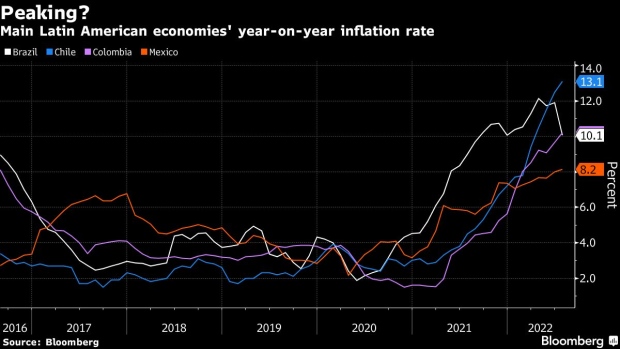Aug 17, 2022
Big Banks Are Wary of Hasty Bets on Latin American Rate Cuts
, Bloomberg News

(Bloomberg) -- As many investors pivot to strategies that profit from a drop in interest rates in Latin America, some big banks are warning that it’s too early to declare victory over inflation.
Bank of America Corp. said rates in the region may stay high for longer than markets are expecting, and it’s worth holding onto positions that benefit from an increase in rates in countries such as Mexico and Chile. Goldman Sachs Group Inc. said investors should be selective when adding receivers -- positions that profit from a drop in rates -- as price growth hasn’t peaked.
Bets that rates are set to fall came after a softer-than-expected US inflation print fueled hopes of a less aggressive Federal Reserve tightening. Latin America has been the most popular destination for such bets as central banks in the region were among the first to start hiking rates and may be the first to consider cuts, with Brazil being the prime example.
“While we believe the front-end of the curve is roughly in line with our views about the path of monetary policy, we continue to think that the market is pricing too many cuts too quickly,” BofA analysts Claudio Irigoyen and Christian Gonzalez Rojas wrote in a note this week. “Therefore, our view is that risk-reward of fading out dovish swings in the market is attractive.”
Swap rates in the main developing economies have been on a downward trend since late July, when fears of a global recession picked up. It’s the opposite of the prevailing mindset in the first half of the year, which focused on rate hikes due to rampant inflation.
Some of the biggest drops in swap rates were seen in Latin America, where the monetary tightening cycle is at a more advanced stage in many countries. Brazil’s DI swap rate through January 2025 is down more than 180 basis points since reaching a peak late last month.
In Chile, the two-year Camara rate has fallen 70 basis points from a mid-July high, while Colombia’s same-maturity IBR rate fell about 120 basis points over the same period. In Mexico, the two-year TIIE is down 65 basis points in the past month. On Wednesday, rates rose across the board, tracking a jump in US Treasury yields.
Still, inflation in those countries remains at multi-year highs, well above the central bank target, and has started to come down only in Brazil.
For BofA, the recent moves open an opportunity to pay rates in Mexico, which is unlikely to tighten its rate spread to the US anytime soon, and in Chile, where inflation continues to accelerate. In Colombia, the bank recommends betting on a flatter curve, as markets are front-loading cuts.
Others including Barclays and BBVA have also warned against hasty bets on lower Mexican rates.
“Inflation needs to peak for there to be a more sustained and broad-based rally in EM local rates,” Goldman analysts including Kevin Daly and Tadas Gedminas wrote in a note this week. “While we expect inflation across LatAm and CEEMEA to peak in the coming months as a result of base effects in energy and food prices, it is nevertheless likely to remain higher for longer than previously appeared likely.”
Brazil seems to be the exception, where most agree the drop in rates is justifiable given the recent guidance from the central bank. After raising rates by 11.75 percentage points since early 2021, policy makers signaled the cycle may be over and traders have been paring wagers on a last hike in September.
“Countries like Brazil and Mexico, particularly the former, seem to be further along in the rate hiking cycle than overall EM,” said Todd Schubert, head of fixed-income research at Bank of Singapore. “I would want to be long duration in Brazil and favor swap receivers in Brazil.”
(Updates with rates moves in seventh paragraph.)
©2022 Bloomberg L.P.






